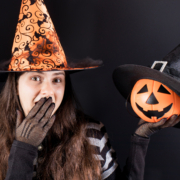The SAT writing section includes questions from two main categories: standard English conventions and expression of ideas.
Questions that focus on standard English conventions cover a wide variety of grammar, usage, and mechanics rules—they require you to evaluate whether the writing is technically correct. With some exceptions, these questions usually appear as an underlined portion of the passage with several alternative replacements. Your job is to choose which version is the most grammatically correct. These questions are easier to answer if you can identify the error being tested. If, for example, you see a subject-verb agreement error, you can quickly eliminate any answer choices that don’t fix the problem.
The rest of the questions on the SAT writing section look at the writer’s ability to express ideas—they require you to evaluate whether the writing is any good. These questions ask you to assess word choice, style, organization, and use of information. Often—though certainly not always!—you’ll see an actual question followed by several answer choices (as opposed to an underlined portion with alternative choices). You’ll need to look for the answer choices that are most stylistically appropriate and that include the most relevant information.
The best way to prep for the SAT writing section is to practice, so we’ve put together an SAT writing practice passage with answers and explanations below. Good luck!
Practice Passage
|
[1] Although we tend to think of changing seasons as a gradual shift, this (1) exclusive moment each December, when the sun appears to shine farthest to the south of the equator, marks the winter solstice—the beginning of winter.
[2] Starting with the summer solstice in June, the altitude of the midday sun lowers each day as its rays migrate south. Finally, the sun reaches the end of its journey and returns north. {2}
[3] Ancient skywatchers had no understanding of the sun’s migration; they believed this celestial machinery might one day break down, allowing the sun to sink further southward, never to return. The lowering of the sun was cause for fear and wonder. When the ancients saw the sun begin to reverse its descent, they (3) rejoiced: here was the promise that spring would return.
[4] The annual winter solstice became a time of celebration. In Persia, the solstice is associated with the triumph of Mithra, the Sun King, over darkness. In ancient Rome, the solstice marked Saturnalia, a bacchanalian thanksgiving. Among the pagans of Northern Europe, the longest night of the year was (4) awarded as Yule.
[5] Throughout history and across the globe, the winter solstice has been a time for family and community gatherings, feasts, and the exchanging of (5) gifts, but today, most cultures continue to hold some form of celebration at this time of year.
[6] Christians celebrate Christmas on December 25, near the winter solstice, because Pope Julius I choose this date to celebrate the Feast of the Nativity, (6) the name originally given to the celebration of the birth of Christ. As the religious celebration spread, it absorbed many of the older customs associated with winter solstice. In fact, historians trace traditions ranging from Christmas trees to Santa Claus back to some of these ancient celebrations. {7}
[7] (8) In East Asia, the Chinese, Japanese, and Koreans celebrate Dongzhi Festival, a time for (9) family gatherings; feasts and traditional foods. The festival celebrates the return of the sun, representing an increase in positive energy.
[8] In Iran, Shab-e Yalda celebrates the victory of light over darkness. Marked by family gatherings, candles, poetry, and feasts, Yalda has ancient Persian (10) root and stem from Zoroastrian beliefs surrounding the winter solstice.
[9] (11) Even from the perspective, with its electric lights keeping the dark at bay, of the modern world, it is easy to see why people celebrate the return of longer days. The shortest day of the year promises the return of spring, warmth, and sunlight—artificial light and heat cannot match the fundamental joy of spring. |
1.
A) NO CHANGE B) specific C) explicit D) peculiar 2. To improve the organization of the passage as a whole, paragraph 2 should be placed A) where it is now. B) at the beginning of paragraph 1. C) at the end of the passage. D) after paragraph 4. 3. A) NO CHANGE B) were rejoicing C) had been rejoicing D) rejoice 4. A) NO CHANGE B) publicized C) observed D) celebrated 5. A) NO CHANGE B) gifts, which today C) gifts. Today D) gifts today 6. The author is considering deleting the underlined portion. Should this change be made? A) Yes, because the information is not relevant to the passage. B) Yes, because the information is redundant. C) No, because the information clarifies an earlier term. D) No, because the information explains why the date was chosen. 7. Which of the following, if added here, would best develop the idea presented in the previous sentence? A) However, many modern Christmas traditions can be more accurately attributed to Charles Dickens, whose holiday works contributed to the Victorian revival of Christmas celebrations. B) Interestingly, however, Santa Claus is a character whose mythology continues to evolve to this day. For example, Rudolf and Santa’s elves are a much more modern addition to Christmas. C) Still, the modern iterations of such traditions bear little resemblance to their ancient counterparts. D) For example, holly wreaths were a hallmark of the Roman Saturnalia celebrations. As Christianity became increasingly common, the wreaths became a Christmas tradition. 8. A) NO CHANGE B) In East Asia, people from China, the Japanese, and Koreans celebrate C) In East Asia, the Chinese Japanese, and people from Korea celebrate D) In East Asia, China, Japan, and Koreans celebrate 9. A) NO CHANGE B) family gatherings, feasts, and traditional foods C) family gatherings: feasts and traditional foods D) family gatherings; feasts; and traditional foods 10. A) NO CHANGE B) roots and stem C) roots and stems D) root and stems 11. A) NO CHANGE B) Even from the perspective, keeping the dark at bay, of the modern world, with its electric lights, C) With its electric lights keeping the dark at bay, even from the perspective of the modern world, D) Even from the perspective of the modern world, with its electric lights keeping the dark at bay,
|
Answer Explanations
- B. This question focuses on word choice—which word best suits the context of the passage? Based on the context, we can see that the author is referring to a particular moment. Choice A connotes something that is restricted or available only to a few; choice C connotes something that is plainly stated or clear; and choice D connotes something that is strange. Only choice B supports the contrast between a gradual shift and a particular moment of change.
- B. For an organization question like this one, we need to consider how paragraph 2 relates to other parts of the passage. The phrase “this moment” in paragraph 1 seems to refer to the time when “the sun reaches the end of its journey and returns north.” This relationship indicates that we need to place paragraph 2 before the reference to “this moment.” Only choice B accomplishes this.
- A. The action is taking place in the past (“when the ancients saw…”), so we need to use the simple past tense as in choice A.
- D. This is another word choice question. The word in question is part of a paragraph discussing different celebrations. Positive word choices such as “celebration,” “triumph,” and “thanksgiving” indicate that we should use a positive word choice here as well. Choice C, observed, is very neutral, so it is not the strongest answer choice. Choices A and B, while generally positive, do not quite suit the context of the sentence—a night is unlikely to receive an award, and there probably weren’t many publicists among the pagans. Choice D is the most contextually appropriate answer.
- C. The original version uses a conjunction that doesn’t accurately define the relationship between the two independent clauses—there is no contrast between the first and second idea. Choice B illogically creates a modifying phrase that doesn’t seem to modify anything. Choice D creates a run-on sentence. Only choice C is both mechanically correct and logical.
- C. The information defines the Feast of the Nativity, a phrase that many readers may not know. We should, therefore keep the underlined portion for the sake of clarity.
- D. Only choice D offers an example of a Christmas tradition that stems from an ancient solstice celebration, so choice D offers the best detail to develop the idea already presented in the previous sentence.
- A. The underlined portion contains items in a series. Items in a series need to be parallel, which means that they should all be in the same form. Only choice A presents the items in the series in the same form.
- B. The underlined portion contains items in a series. Since none of the items already contains a comma and since none are particularly long, the items should be separated by commas. Only choice B correctly punctuates the list of items.
- C. We must look beyond the underlined portion to determine the parts of speech here. The word “root” refers to the origins of Yalda; in this particular usage, it needs to be plural. The word “stem” is part of a compound predicate, the subject of which is the singular Yalda, so we need to use the singular “stems.”
- D. The underlined portion contains a misplaced modifier. The Portion of the sentence within the commas (“with…bay”) seems intended to refer to the “modern world” (our clue is the pronoun “its”—the electric lights belong to the modern world). Only choice D correctly places this modifier near the object being modified.
Get Help on the SAT Writing Section
Looking for more SAT writing practice opportunities? Contact your local C2 Education center for a free consultation and learn where you can improve your SAT prep efforts for test day.









